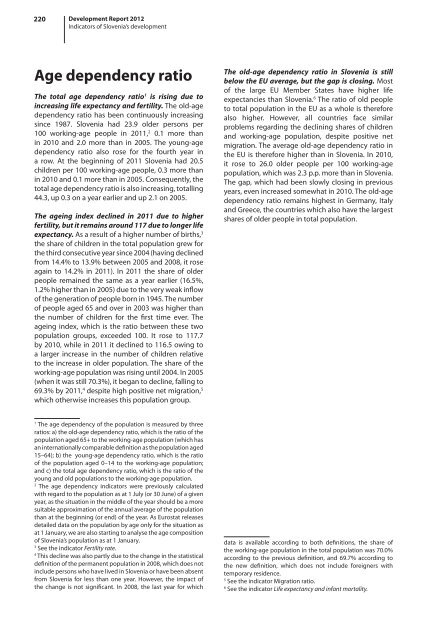development report 2012 - UMAR
development report 2012 - UMAR
development report 2012 - UMAR
Create successful ePaper yourself
Turn your PDF publications into a flip-book with our unique Google optimized e-Paper software.
220 Development Report <strong>2012</strong><br />
Indicators of Slovenia’s <strong>development</strong><br />
Age dependency ratio<br />
The total age dependency ratio 1 is rising due to<br />
increasing life expectancy and fertility. The old-age<br />
dependency ratio has been continuously increasing<br />
since 1987. Slovenia had 23.9 older persons per<br />
100 working-age people in 2011, 2 0.1 more than<br />
in 2010 and 2.0 more than in 2005. The young-age<br />
dependency ratio also rose for the fourth year in<br />
a row. At the beginning of 2011 Slovenia had 20.5<br />
children per 100 working-age people, 0.3 more than<br />
in 2010 and 0.1 more than in 2005. Consequently, the<br />
total age dependency ratio is also increasing, totalling<br />
44.3, up 0.3 on a year earlier and up 2.1 on 2005.<br />
The ageing index declined in 2011 due to higher<br />
fertility, but it remains around 117 due to longer life<br />
expectancy. As a result of a higher number of births, 3<br />
the share of children in the total population grew for<br />
the third consecutive year since 2004 (having declined<br />
from 14.4% to 13.9% between 2005 and 2008, it rose<br />
again to 14.2% in 2011). In 2011 the share of older<br />
people remained the same as a year earlier (16.5%,<br />
1.2% higher than in 2005) due to the very weak inflow<br />
of the generation of people born in 1945. The number<br />
of people aged 65 and over in 2003 was higher than<br />
the number of children for the first time ever. The<br />
ageing index, which is the ratio between these two<br />
population groups, exceeded 100. It rose to 117.7<br />
by 2010, while in 2011 it declined to 116.5 owing to<br />
a larger increase in the number of children relative<br />
to the increase in older population. The share of the<br />
working-age population was rising until 2004. In 2005<br />
(when it was still 70.3%), it began to decline, falling to<br />
69.3% by 2011, 4 despite high positive net migration, 5<br />
which otherwise increases this population group.<br />
The old-age dependency ratio in Slovenia is still<br />
below the EU average, but the gap is closing. Most<br />
of the large EU Member States have higher life<br />
expectancies than Slovenia. 6 The ratio of old people<br />
to total population in the EU as a whole is therefore<br />
also higher. However, all countries face similar<br />
problems regarding the declining shares of children<br />
and working-age population, despite positive net<br />
migration. The average old-age dependency ratio in<br />
the EU is therefore higher than in Slovenia. In 2010,<br />
it rose to 26.0 older people per 100 working-age<br />
population, which was 2.3 p.p. more than in Slovenia.<br />
The gap, which had been slowly closing in previous<br />
years, even increased somewhat in 2010. The old-age<br />
dependency ratio remains highest in Germany, Italy<br />
and Greece, the countries which also have the largest<br />
shares of older people in total population.<br />
1<br />
The age dependency of the population is measured by three<br />
ratios: a) the old-age dependency ratio, which is the ratio of the<br />
population aged 65+ to the working-age population (which has<br />
an internationally comparable definition as the population aged<br />
15–64); b) the young-age dependency ratio, which is the ratio<br />
of the population aged 0–14 to the working-age population;<br />
and c) the total age dependency ratio, which is the ratio of the<br />
young and old populations to the working-age population.<br />
2<br />
The age dependency indicators were previously calculated<br />
with regard to the population as at 1 July (or 30 June) of a given<br />
year, as the situation in the middle of the year should be a more<br />
suitable approximation of the annual average of the population<br />
than at the beginning (or end) of the year. As Eurostat releases<br />
detailed data on the population by age only for the situation as<br />
at 1 January, we are also starting to analyse the age composition<br />
of Slovenia’s population as at 1 January.<br />
3<br />
See the indicator Fertility rate.<br />
4<br />
This decline was also partly due to the change in the statistical<br />
definition of the permanent population in 2008, which does not<br />
include persons who have lived in Slovenia or have been absent<br />
from Slovenia for less than one year. However, the impact of<br />
the change is not significant. In 2008, the last year for which<br />
data is available according to both definitions, the share of<br />
the working-age population in the total population was 70.0%<br />
according to the previous definition, and 69.7% according to<br />
the new definition, which does not include foreigners with<br />
temporary residence.<br />
5<br />
See the indicator Migration ratio.<br />
6<br />
See the indicator Life expectancy and infant mortality.
















